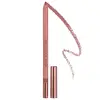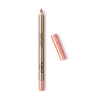What's inside
What's inside
 Key Ingredients
Key Ingredients

 Benefits
Benefits

No benefits
 Concerns
Concerns

 Ingredients Side-by-side
Ingredients Side-by-side

Dimethicone
EmollientTrimethylsiloxysilicate
EmollientSynthetic Wax
AbrasiveMica
Cosmetic ColorantDicalcium Phosphate
AbrasivePhenylpropyldimethylsiloxysilicate
EmollientCI 77891
Cosmetic ColorantPolyethylene
AbrasiveCI 77492
Cosmetic ColorantAcrylates/Stearyl Acrylate/Dimethicone Methacrylate Copolymer
Polyhydroxystearic Acid
EmulsifyingCI 77491
Cosmetic ColorantDisteardimonium Hectorite
StabilisingAluminum Hydroxide
EmollientCaprylyl Methicone
Skin ConditioningCaprylic/Capric Triglyceride
MaskingCI 15850
Cosmetic ColorantCI 42090
Cosmetic ColorantPropylene Carbonate
SolventPentaerythrityl Tetra-Di-T-Butyl Hydroxyhydrocinnamate
AntioxidantTocopherol
AntioxidantCI 15985
Cosmetic ColorantCI 19140
Cosmetic ColorantRubus Idaeus Leaf Extract
Skin ConditioningDimethicone, Trimethylsiloxysilicate, Synthetic Wax, Mica, Dicalcium Phosphate, Phenylpropyldimethylsiloxysilicate, CI 77891, Polyethylene, CI 77492, Acrylates/Stearyl Acrylate/Dimethicone Methacrylate Copolymer, Polyhydroxystearic Acid, CI 77491, Disteardimonium Hectorite, Aluminum Hydroxide, Caprylyl Methicone, Caprylic/Capric Triglyceride, CI 15850, CI 42090, Propylene Carbonate, Pentaerythrityl Tetra-Di-T-Butyl Hydroxyhydrocinnamate, Tocopherol, CI 15985, CI 19140, Rubus Idaeus Leaf Extract
Isododecane
EmollientMica
Cosmetic ColorantSynthetic Wax
AbrasivePolybutene
Trimethylsiloxysilicate
EmollientSucrose Tetrastearate Triacetate
EmollientIsoamyl Laurate
EmollientSilica
AbrasiveHydrogenated Jojoba Oil
AbrasiveCetearyl Behenate
EmollientSynthetic Fluorphlogopite
Pentaerythrityl Tetra-Di-T-Butyl Hydroxyhydrocinnamate
AntioxidantCI 77891
Cosmetic ColorantCI 15850
Cosmetic ColorantCI 77491
Cosmetic ColorantCI 45410
Cosmetic ColorantCI 19140
Cosmetic ColorantCI 77742
Cosmetic ColorantCI 15985
Cosmetic ColorantCI 42090
Cosmetic ColorantIsododecane, Mica, Synthetic Wax, Polybutene, Trimethylsiloxysilicate, Sucrose Tetrastearate Triacetate, Isoamyl Laurate, Silica, Hydrogenated Jojoba Oil, Cetearyl Behenate, Synthetic Fluorphlogopite, Pentaerythrityl Tetra-Di-T-Butyl Hydroxyhydrocinnamate, CI 77891, CI 15850, CI 77491, CI 45410, CI 19140, CI 77742, CI 15985, CI 42090
Ingredients Explained
These ingredients are found in both products.
Ingredients higher up in an ingredient list are typically present in a larger amount.
Ci 15850 is the pigment color red. It is an azo dye and created synthetically.
Azo dyes need to be thoroughly purified before use. This allows them to be more stable and longer-lasting.
This ingredient is common in foundations, lipsticks, and blushes. This color is described as brown/orangey red.
It has many secondary names such as Red 6 and Red 7. According to a manufacturer, Red 6 usually contains aluminum.
Learn more about CI 15850Ci 15985 is a dye made from petroleum. It is synthetically created and approved by the FDA for use in foods and cosmetics.
The color of this dye is orange/yellow.
This ingredient can be found in makeup, sun care, and skincare.
Learn more about CI 15985CI 19140 is also known as Tartrazine. Tartrazine is a synthetic dye used in cosmetics, foods, and medicine to add a yellow color.
Tartrazine is created from petroleum and is water-soluble.
Some people may experience allergies from this dye, especially asthmatics and those with an aspirin intolerance.
Learn more about CI 19140Ci 42090 is a synthetic dye created from petroleum. It is used to give a bright blue color to cosmetics, medicine, and food.
Ci 77491 is also hydrated iron III oxide. It's sole purpose is to give a red/pink hue to products.
Iron III oxides are classified as inorganic chemicals for coloring.
Synthetically created Ci 77491 is considered safer than those naturally found. This is because the synthetically created version may contain less impurities. Iron oxides are generally non-toxic and non-allergenic.
Learn more about CI 77491Ci 77891 is a white pigment from Titanium dioxide. It is naturally found in minerals such as rutile and ilmenite.
It's main function is to add a white color to cosmetics. It can also be mixed with other colors to create different shades.
Ci 77891 is commonly found in sunscreens due to its ability to block UV rays.
Learn more about CI 77891Mica is a naturally occurring mineral used to add shimmer and color in cosmetics. It can also help improve the texture of a product or give it an opaque, white/silver color.
Serecite is the name for very fine but ragged grains of mica.
This ingredient is often coated with metal oxides like titanium dioxide. Trace amounts of heavy metals may be found in mica, but these metals are not harmful in our personal products.
Mica has been used since prehistoric times throughout the world. Ancient Egyptian, Indian, Greek, Roman, Aztec, and Chinese civilizations have used mica.
Learn more about MicaPentaerythrityl Tetra-Di-T-Butyl Hydroxyhydrocinnamate (long name, huh?) is a synthetic antioxidant.
It is used to help stabilize other antioxidants or prevent the color from changing in a product.
As an antioxidant, it helps fight free-radical molecules. Free-radical molecules are capable of damaging our cells and other genetic material. Thus, antioxidants may reduce the signs of aging.
This ingredient is oil-soluble.
Learn more about Pentaerythrityl Tetra-Di-T-Butyl HydroxyhydrocinnamateSynthetic Wax is created from fossil fuels such as natural gas. It is used to enhance texture, adjust pH, and as an occlusive.
It may also be used as an abrasive ingredient to exfoliate the skin.
Synthetic Wax may not be fungal acne safe.
Learn more about Synthetic WaxThis silicone is an emollient. Emollients create a thin film on the skin to prevent moisture from escaping.
It is not soluble in water and helps increase water-resistance in products.
According to a manufacturer, it can blend seamlessly with silicone oils, such as Cyclopentasiloxane.
Learn more about Trimethylsiloxysilicate